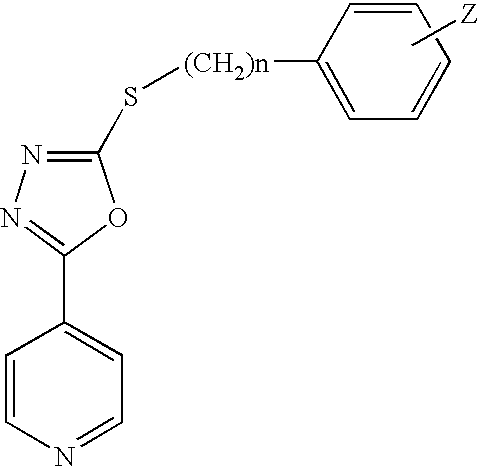Gsk-3betainhibitor
a technology of gsk-3beta and inhibitor, which is applied in the field of oxadiazole compounds, can solve the problems of insufficient selectivity to other, and the satisfaction of pharmaceutical agents has not been achieved entirely
- Summary
- Abstract
- Description
- Claims
- Application Information
AI Technical Summary
Benefits of technology
Problems solved by technology
Method used
Image
Examples
reference example 2
benzothiazole-6-carbohydrazide trifluoroacetate
[1659]A mixture of tert-butyl 2-(benzothiazol-6-ylcarbonyl)hydrazinecarboxylate (5.28 g, 18.0 mmol) and trifluoroacetic acid (20 mL) was stirred at room temperature for 1 hr. Trifluoroacetic acid was evaporated under reduced pressure, and the residue was recrystallized from ethanol to give the title compound (5.18 g, yield 94%) as colorless crystals.
[1660]melting point 154-155° C.
[1661]1H NMR (DMSO-d6) δ 8.01 (1H, dd, J=1.7, 8.7 Hz), 8.22 (1H, d, J=0.6, 8.7 Hz), 8.74 (1H, dd, J=0.6, 1.7 Hz), 9.60 (1H, s), 11.24 (1H, brs).
[1662]Elemental analysis (for C10H8F3N3O3S)
[1663]Calculated (%): C, 39.09; H, 2.62; N, 13.68.
[1664]Found (%): C, 39.10; H, 2.50; N, 13.75.
reference example 3
5-(benzothiazol-6-yl)-1,3,4-oxadiazole-2-thiol
[1665]A suspension of benzothiazole-6-carbohydrazide trifluoroacetate (4.92 g, 16.0 mmol), carbon disulfide (2.41 mL, 40.0 mmol) and triethylamine (5.58 mL, 40.0 mmol) in ethanol (60 mL) was heated under reflux. for 1.5 hr. After cooling, the reaction mixture was diluted with ethyl acetate / tetrahydrofuran, washed with 1M hydrochloric acid and water, and concentrated under reduced pressure. The residue was recrystallized from tetrahydrofuran to give the title compound (3.11 g, yield 83%) as pale-yellow crystals.
[1666]melting point 274-275° C.
[1667]1H NMR (DMSO-d6) δ 8.03 (1H, dd, J=1.7, 8.7 Hz), 8.26 (1H, dd, J=0.6, 8.7 Hz), 8.81 (1H, dd, J=0.6, 1.7 Hz), 9.59 (1H, s), 14.78 (1H, brs).
[1668]Elemental analysis (for C9H5N3OS)
[1669]Calculated (%): C, 45.94; H, 2.14; N, 17.86.
[1670]Found (%): C, 45.81; H, 2.13; N, 17.72.
reference example 4
3-[3-(trifluoromethyl)phenyl]propanohydrazide
[1671]A solution of ethyl 3-[3-(trifluoromethyl)phenyl]propionate (9.85 g, 40.0 mmol) and hydrazine monohydrate (9.70 mL, 200 mmol) in ethanol (50 mL) was heated under reflux overnight. After cooling, the reaction mixture was concentrated under reduced pressure. The residue was diluted with ethyl acetate, washed with saturated brine, dried over anhydrous sodium sulfate, and concentrated under reduced pressure. The residue was purified by basic silica gel column chromatography (ethyl acetate) and recrystallized from hexane / ethyl acetate to give the title compound (7.51 g, yield 81%) as colorless crystals.
[1672]melting point 80-81° C.
[1673]1NMR (CDCl3) δ 2.44-2.49 (2H, m), 3.02-3.07 (2H, m), 3.87 (2H, d, J=4.0 Hz), 6.65 (1H, brs), 7.36-7.51 (4H, m).
[1674]Elemental analysis (for C10H11F3N2O)
[1675]Calculated (%): C, 51.73; H, 4.77; N, 12.06.
[1676]Found (%): C, 51.70; H, 4.65; N, 12.26.
PUM
 Login to View More
Login to View More Abstract
Description
Claims
Application Information
 Login to View More
Login to View More - R&D
- Intellectual Property
- Life Sciences
- Materials
- Tech Scout
- Unparalleled Data Quality
- Higher Quality Content
- 60% Fewer Hallucinations
Browse by: Latest US Patents, China's latest patents, Technical Efficacy Thesaurus, Application Domain, Technology Topic, Popular Technical Reports.
© 2025 PatSnap. All rights reserved.Legal|Privacy policy|Modern Slavery Act Transparency Statement|Sitemap|About US| Contact US: help@patsnap.com



